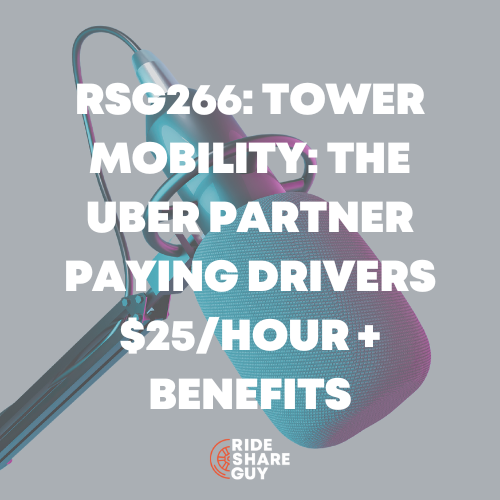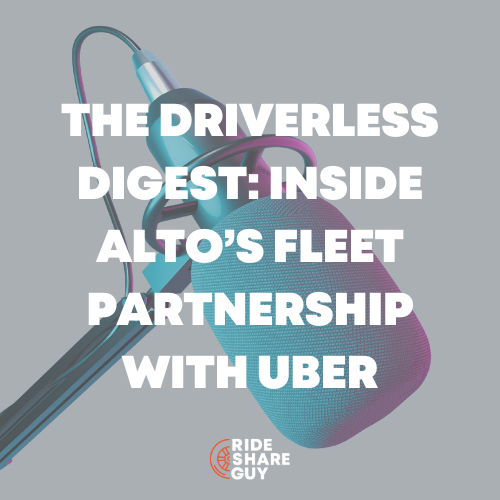Join Harry as he speaks with Jose Carlos Aguilar, director of operations for MI NAVE, a company that offers the best vehicles for all mobility apps. Harry and Jose discuss the rideshare market in Latin America and the up-and-coming app DiDi, which we don’t have in the United States but has a 50% market share in Latin America.
Listen to RSG257 With Jose Carlos Aguilar
If you like podcasts better, check us out on Apple Podcasts or Spotify! While you’re there, hit subscribe so you don’t miss our latest episodes!
Quick Takeaways
- DiDi is the difference between rideshare in the United States and Latin America. It is the second biggest company in the world.
- DiDi started in Mexico about six years ago, and it came with a very heavy investment proposal to gain market share.
- There has been what they call an ‘app war’ between Uber and DiDi, which started in China and translated to Mexico when they entered that market. This is good news for drivers because it means both companies are investing heavily in their apps.
- The market share between Uber and DiDi is almost 50/50 in Mexico.
- Even with DiDi sharing a large part of the market, it’s commonplace for people to say, ‘I’m going to order an Uber,’ even if they order a DiDi.
- Public transportation in Mexico is not good. Rideshare is one of the main ways people move around, especially in Mexico City.
- When riders choose Uber, it’s about a recognizable brand, but with DiDi, they know they are getting more value for their money.
- Latin America has a lot of room for growth for both Uber and DiDi. In one to two months, you can be getting over 200,000 rides per month, but there’s still room to grow.
- In the US, Uber is at peak pricing regarding what it can charge for riders. Prices are higher than ever, and drivers are making less because there are so many drivers.
- Ride-hailing is the prominent earnings for these companies, and the profits help support the company’s other verticals. (It’s the cash cow).
- The less market share you have in a city, the more you have to invest. This is the golden rule of ridesharing, which means driver incentives. Both offer guaranteed take rates of 20% for drivers. The average is between 15% and 20%, but in the United States, it’s closer to 30%, which means less money for drivers.
- Rideshare is a good job in Latin America. Competition is fierce in its largest cities, so Uber and DiDi have strong driver incentives, which means good pay.
- There are fewer barriers to becoming a driver for DiDi. You need to upload 4 to 5 documents, such as your driver’s license, insurance, and a few other documents. There’s no cap on the number of drivers a city has, which is bad for drivers.
- Because supply is so high, DiDi has relaxed its vehicle requirements, including allowing older vehicles to entice more drivers. Right now, the requirements are for a car to be no more than ten years old.
- MI NAVE helps drivers get cars. They don’t check credit history. You show your ride-hailing experience and pass a background check, and you can rent a car. They underwrite based on your work history.
- The model is LTO. Drivers pay rent for 36 months, and by the end of that time, they own the car. The rent is higher because of the lease-to-own, but you own a car at the end of the lease. Rent is around $100 to $150 a week, which is much cheaper than in the United States, but the cost of living is lower.
- The earnings potential driving 5 to 6 days a week at 8 hours a day is at least $300 a day. With MI NAVE, you can reduce your rent if you prove you work much more and earn more than the average weekly pay.
- Brazil is an even larger market than Mexico. DiDi is called 99 over there, but because of the number of cities and population, there is a huge market. There is a lot of room for growth.
- It’s a 50/50 battle in Brazil, with only a 10% to 20% take for rideshare companies.
- The competition drives a better experience for riders and drivers. In the US, if Uber continues to have a larger market share, it doesn’t have to invest as much, which means fewer incentives for riders and drivers. Competition is good for everyone.
- DiDi’s cash cow is China. They have a 90% market share there.
- InDrive is another rideshare company. Their tagline is that they are one of the biggest in the country.
- InDrive is a new player in the market, but it’s been around for 3 to 4 years. It was in Mexico during the pandemic. InDrive offers negotiations and takes chances when it comes to regulations. It is also more lenient regarding driver and passenger requirements. It’s also a cash-only app.
- The ratio of cash to credit payment in Mexico is 70/30. Cash is king there with Uber and DiDi.
- Drivers get more liquidity because they are paid in cash. However, carrying that much cash poses a safety issue. Drivers can opt for only credit payments, but they get fewer riders.
- Instant Pay is a popular feature in the United States because it gives drivers liquidity.
- Some drivers only drive for InDrive because they only want to earn cash.
- InDrive also has a very low take rate, which means higher rates for drivers, but they don’t have the largest market share, so it’s a tradeoff for drivers.
- InDrive has been successful in smaller cities in Mexico, but it doesn’t have a large presence in the larger cities.
- The negotiation model allows passengers to offer their price, and as you post your price, the drivers who are nearby will get a notification about the trip. They can counter with a higher price or accept the offer.
- Uber uses a feature called Trip Radar, a dispatch system. Instead of sending a trip offer, they say, ‘Look at these offers. Do you want to take any?’ So, it’s similar to the negotiation platform but with other factors, such as where it’s going, who the rider is, and other non-monetary factors.
- In Mexico, some drivers use the Trip Radar as a complement to their current activities. It’s kind of like a filler that may take them to a busier area of the city.
- Because of InDrive, DiDi and Uber have a negotiation platform to stay competitive. Uber is testing it in 12 to 13 cities, so it’s not available everywhere. DiDi is already testing it in the big cities in Mexico. The passenger decides to choose traditional Uber/DiDi or negotiating fairs.
- The negotiation model benefits both drivers and riders depending on what they want. The downside is you’ll spend more time on the app negotiating with riders. So there is more downtime.
- Passengers have a price advantage. They can spend 30 minutes negotiating prices if they want. But if they are desperate to get somewhere, they can offer a much higher fair so drivers jump at it.
- Regulatory requirements are one step behind those in the United States. It’s still a very unexplored area. The only country in LA to regulate drivers is Chile. They aren’t full-time employees, but they are required to get some type of benefits. They know they have to reach a compromise with other countries in LA.
RSG257: Watch The Podcast On YouTube
Watch our YouTube episode to learn more about Archer Aviation and aviation rideshare. While you’re there, hit subscribe!





